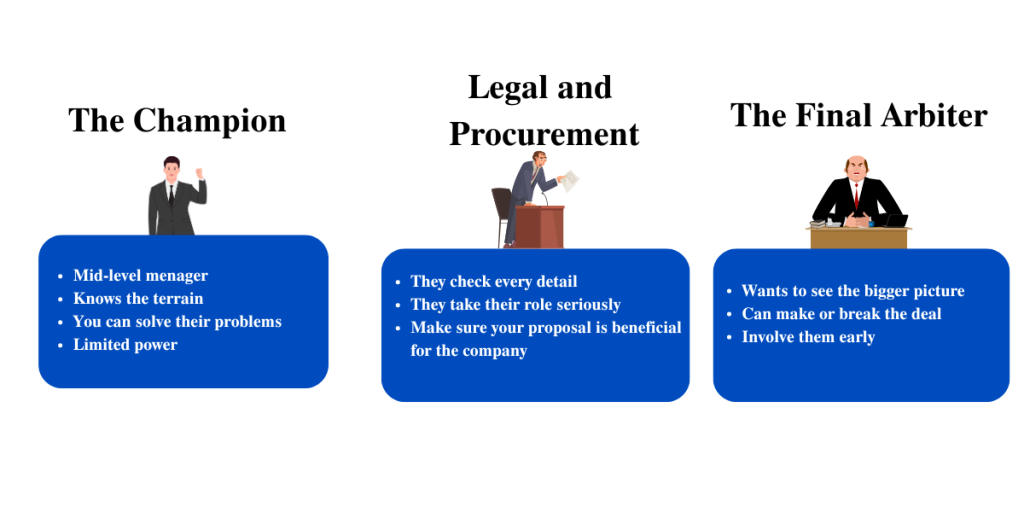Corporate sales—there’s nothing quite like it. Modern organizations’ high stakes, complex decision-making, and labyrinthine structures are not a game for the faint-hearted. No, this is where the real players come to test their mettle, where deals are won and lost in the shadows of boardrooms and back offices. At the heart of this battle lie two key players: the Champion and the Signing Authority. They are your allies, your advocates, and your ticket to success if you play your cards right.
But here’s the thing—these aren’t the only players in the game. Legal and Procurement are lurking in the background, waiting for their moment. They are the hidden gatekeepers who can either accelerate your deal or drag it into the mire of corporate bureaucracy.
Let’s examine how you can master the influence in the sales process and navigate these complex relationships with the precision of a seasoned strategist.
The Champion: Your Vital Ally in the Trenches
Imagine you’re deep in the trenches, with the roar of battle all around you. The Champion stands as your trusted ally, knowing the terrain, understanding the enemy, and ready to fight alongside you. They believe in your product, see its value, know it can solve their problems, and are willing to go to bat for you. Often, a mid-level manager or department head directly affected by the problem your product solves, the Champion has the influence to push your solution within the organization.
But here’s the catch: while the Champion is essential, their power is often limited. They can advocate and influence, but their reach may fall short when it comes to sealing the deal. That’s why you must empower the Champion. Equip them with detailed product information, case studies, and customer testimonials. Involve them in strategic planning and ensure they have the backing to push the deal through.
The Champion isn’t just a supporter; they’re a co-conspirator in your mission to win the deal. Treat them as such, and you’ll have a powerful ally in your corner.
The Signing Authority: The Final Arbiter
If the Champion is your ally in the trenches, the Signing Authority is the final arbiter who can make or break your deal with a single decision. Your strategic approach can influence their decision, making you feel empowered and in control.
Winning over the Signing Authority requires a different approach. They are not interested in the details; they want to see the big picture. How does your product align with the company’s strategic goals? What’s the return on investment? What risks are involved, and how are they mitigated?
To effectively engage the Signing Authority, you need to involve them early. Don’t wait until the last minute to bring them into the conversation. Engage them in strategic discussions, show them the value of your product, and ensure they understand why this deal is essential. This early engagement builds buy-in and reduces the chances of last-minute objections that could derail the deal.
The Legal and Procurement Obstacle Course
As you secure the support of the Champion and the Signing Authority, the real test awaits with Legal and Procurement. These departments often appear as the final obstacles in the sales process—the bureaucratic red tape that slows everything down. However, they are key players you must win over to close the deal.
Legal: Legal serves as the guardian of corporate risk. They scrutinize every detail to ensure the contract is airtight and the company is protected. They aren’t there to complicate your work; they take their role seriously and are committed to doing their job.
Procurement: Procurement focuses on value, negotiating the best terms and ensuring the deal aligns with the company’s budget and policies. As financial gatekeepers, they challenge every aspect of your proposal to make sure it benefits the company.

Turning Legal into an Ally
The key to navigating Legal is to stop seeing them as an adversary. Instead, engage them early and bring them into the conversation as partners. Provide them with the information they need upfront, address potential concerns before they become deal-breakers, and show them that you are prepared to work with them, not against them.
Involving Legal early transforms them from a roadblock into an ally. This approach speeds up the sales process and reduces the chances of last-minute surprises that could derail the deal.
Mastering Procurement: The Final Negotiation
Procurement is the final hurdle; the department will scrutinize your pricing, challenge your terms, and ensure that the deal is financially sound. However, Procurement is not just there to drive a hard bargain; it is there to ensure that the deal makes sense for the company as a whole.
To succeed with Procurement, you need to be prepared. Know your numbers, understand the company’s procurement policies, and be ready to negotiate. But more than that, you need to build a relationship. Procurement officers are often seen as adversaries but can be valuable allies. By working with them rather than against them, you can find solutions that work for both parties.
The Mutual Action Plan: Your Blueprint for Success
The Mutual Action Plan (MAP) is your key to navigating this complex web of relationships. It’s more than just a timeline; it’s a strategic document that aligns all parties—Champion, Signing Authority, Legal, and Procurement—around a common goal. With this plan, you’ll feel organized and prepared for every step of the sales process.
A well-crafted MAP outlines every step needed to close the deal, from the initial discovery call to the final contract signing. It clarifies roles and responsibilities, sets expectations, and establishes clear timelines. But more importantly, it keeps everyone on the same page, ensuring no one is left in the dark or caught off guard by the next step.
The MAP should be a living document, evolving as the deal progresses. It’s not just a tool for the sales team; it’s a resource for the entire buying team. Keeping the MAP updated and sharing it with all stakeholders creates transparency and builds trust—two critical components in any successful sales process. If you or your team would like to learn more about creating the MAP, check out our sales implementation courses.
The Final Push: Closing the Deal
As you reach the final stages of the sales process, you must bring all the pieces together: the Champion, the Signing Authority, Legal, and Procurement. Each plays a critical role, and it’s up to you to engage and align them to close the deal successfully.
Let the MAP guide you, ensuring nothing is overlooked and everyone stays on the same page. But even with a solid plan, the final push demands your focus, determination, and attention to detail. You must pull everything together, leveraging the relationships you’ve built and the strategies you’ve employed to close the deal.
Your goal isn’t just to close the deal—it’s to close it in a way that satisfies all parties. A successful sale leaves the Champion feeling vindicated, the Signing Authority seeing the value, Legal confident in the company’s protection, and Procurement satisfied with the deal. When you align these elements, you close the deal and lay the foundation for a long-term, mutually beneficial relationship.
Conclusion: The Art of Corporate Sales
In corporate sales, success is about more than just persuasion—strategy, preparation, and the ability to navigate complex relationships. By leveraging the influence in the sales process of your Champion and the Signing Authority and engaging Legal and Procurement early and effectively, you can turn even the most challenging sales process into a triumph.
But remember, this is an art, not a science. Every deal and company is unique, and strategies that work in one situation may not work in another. The key is to remain flexible, adapt your approach as needed, and never lose sight of the ultimate goal: closing the deal and building lasting, valuable relationships.
This is how you not only survive in the world of corporate sales—but thrive.

